Haworthia succulents are small, interesting plants that store water in their thick fleshy leaves, enabling them to go without a drink for many weeks. But do you know how many types of Haworthia succulents exist? There are hundreds!
Let’s take a look at some different types of Haworthias and learn how to look after them, but first, what are Haworthia succulents?
What Are Haworthia Succulents?
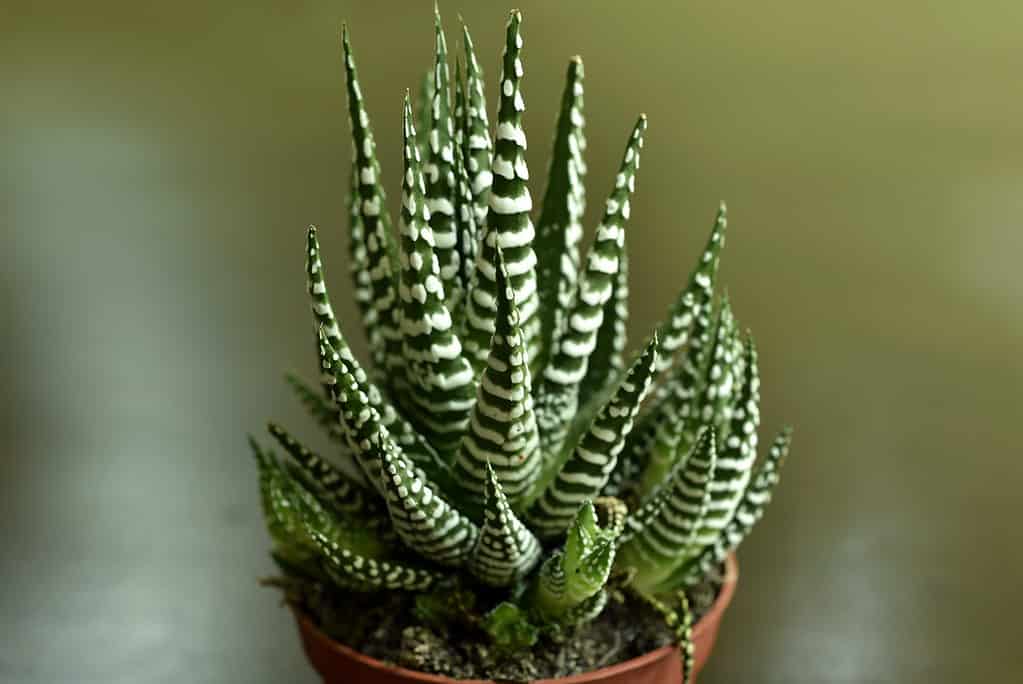
There are around 160 species of haworthia and many more cultivars bred by botanists.
©iStock.com/WhiteLacePhotography
Haworthia succulents are a genus of plants native to South Africa. They are in the Asphodeloideae family, alongside aloes.
They appear similar to aloes but have flowers that bloom more easily and frequently, especially when they are kept as houseplants.
There are around 160 species of Haworthia and many more cultivars bred by botanists. They are easy to recognize because they have rosette-like long triangular leaves that grow from a short central stem.
The genus is named after Adrian Haworth, an influential English botanist, entomologist (study of insects), and carcinologist (study of crustaceans) who lived from 1767 to 1833.
Haworthia succulents are highly collectible due to their small size and the sheer number of species.
What is a Succulent?
Succulents are a type of plant that stores water in their fleshy leaves. It’s not a genus, but a way to describe plants that are capable of retaining water no matter what their geni.
Succulents grow in every continent except Antarctica and have become very popular in recent years to the point that some plants such as the South African conophytum are under threat of extinction in the wild.
Different Types of Haworthia Succulents
There are over 150 Haworthia species, which is one of the reasons they’re so collectible. Here are some of the most popular species:
Haworthia cooperi

Haworthia Cooperi has translucent leaves.
©Lovelypeace/Shutterstock.com
More commonly known as pussy foot or the transparent succulent, this type of Haworthia has closely clustered shiny cylindrical leaves that grow in a rosette pattern.
When the light shines through the outer leaves they become transparent! This enables the plant to absorb more light. It’s pretty rare and collectors love it.
This little plant reaches 2-3 inches and produces pinky-white flowers in the summer.
Haworthia angustifolia

Haworthia angustifolia has lanceolate thin leaves that appear to sag a little.
©TatjanaVer/Shutterstock.com
This is a Haworthia with lanceolate thin leaves that appear to sag a little. Each leaf has a serrated edge, and they form the typical Haworthia rosette shape. Pink-white flowers appear in summer on thin stems that bend in multiple directions.
Haworthia fasciata
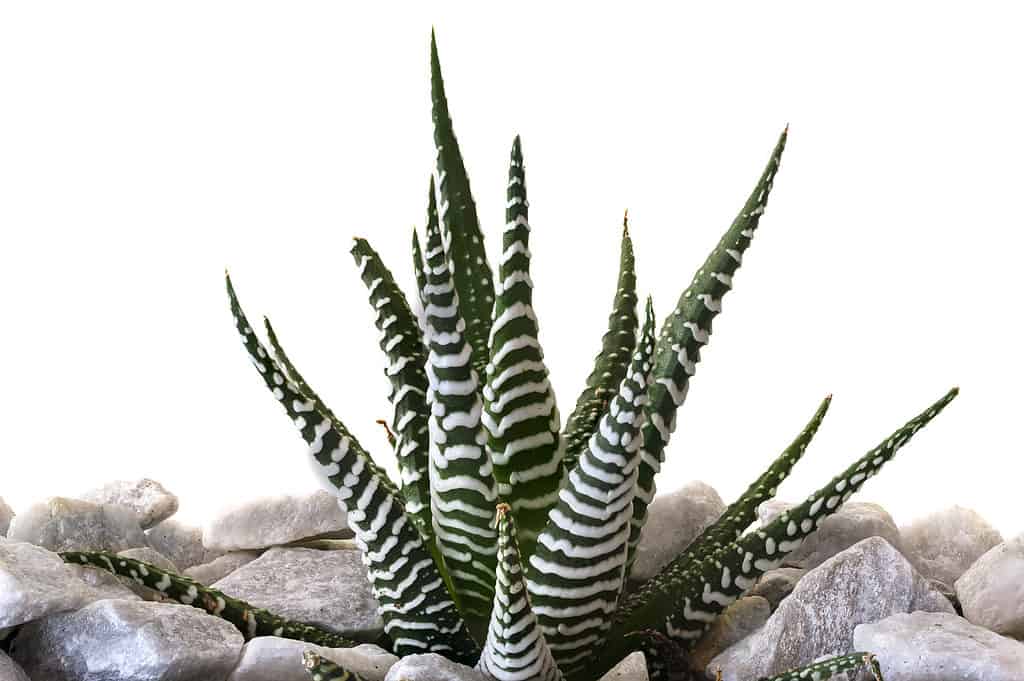
The zebra Haworthia has prominent horizontal white stripes and leaves that typically form a rosette that points upwards.
©iStock.com/RAUL RODRIGUEZ
Better known as the zebra Haworthia, this South African native has prominent horizontal white stripes on its rough green leaves, with a warty feel on the undersides.
Its leaves typically form a rosette that points upwards. It can reach 8 inches tall, and white flowers that match its white stripes appear in summer. This is a very popular Haworthia and a common sight in stores, but it can’t tolerate cold temperatures.
Haworthia limifolia
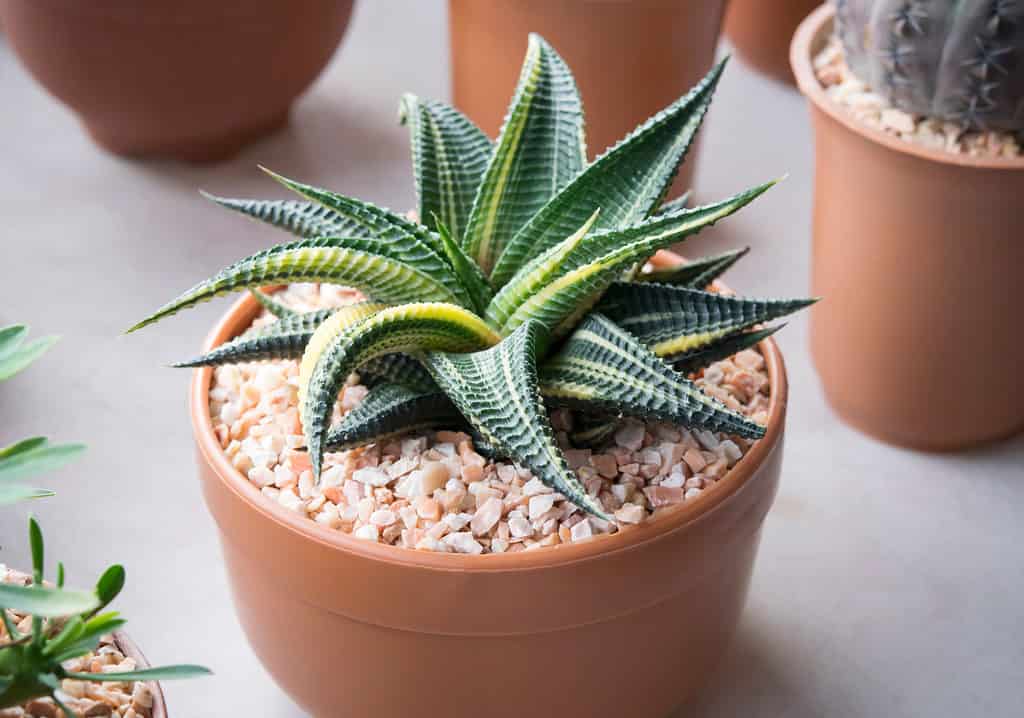
This succulent’s common name is fairy washboard because its tiny leaves have brown, green ridges.
©Nooumaporn/Shutterstock.com
This South African native has the best common name of all the Haworthias: the fairy washboard!
This adorable name comes from its tiny fairy size, as it only reaches 4 inches tall by 1 inch wide. Additionally, its small triangular leaves have distinctive brown, green ridges similar to those of a traditional washboard.
Its rosette-forming leaves are not at all cold tolerant, so it needs an indoor spot or zone 10 and above to thrive. When it’s happy, a 14-inch flower stem emerges topped with tiny white flowers.
Haworthia cymbiformis

Haworthia cymbiformis is a pale green, shade-loving succulent.
©Banbury16/Shutterstock.com
This little Haworthia is named cymbiformis for its boat-shaped leaves (cymbiformis means boat-shaped in Latin).
This succulent is pale green and the tips of its triangular thick leaves have fine lines that let in lots of light. It’s especially tolerant of semi-shade conditions.
In summer, white-pink flowers emerge earlier than those of other Haworthias.
Haworthia trunata
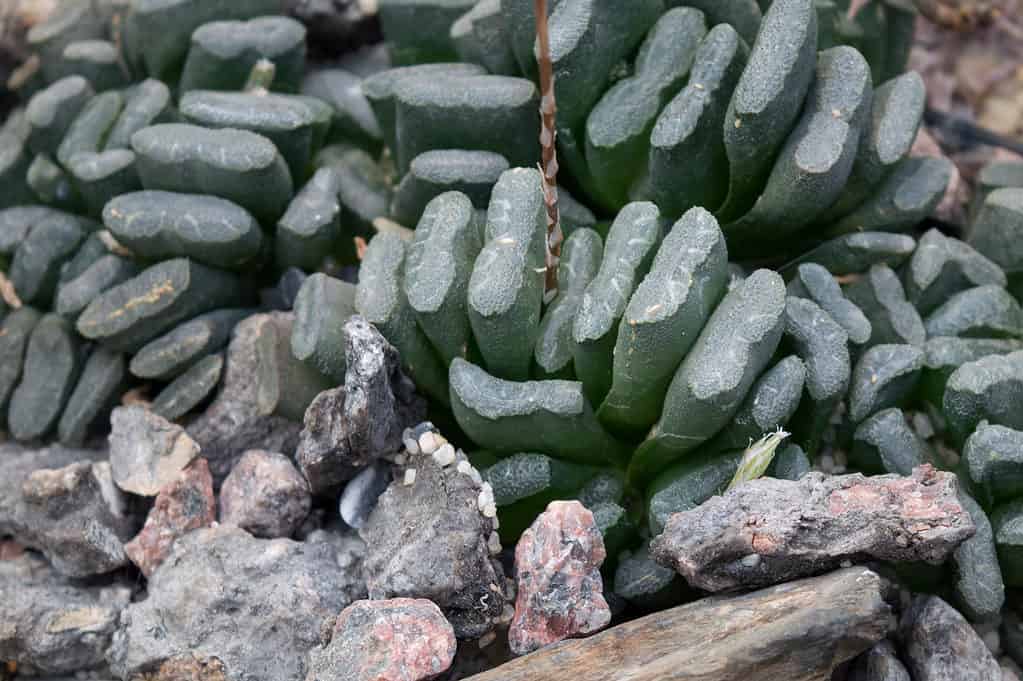
Its thick and chunky gray-green, rectangular leaves resemble
horse
teeth!
©Alina Kuptova/Shutterstock.com
Surely the weirdest of the Haworthias, this little succulent is native to South Africa and better known as horse’s teeth!
The majority of the plant grows beneath the soil and its thick and chunky gray-green, rectangular leaves resemble, you’ve guessed it, horse teeth!
The leaves only reach 3-5 inches tall, but the flower spike tops out at 12 inches with greenish-white flowers blooming in summer.
Haworthia pumila

The Haworthia pumila is often referred to as tear of angels or the pearl plant.
©Marta Nogueira/Shutterstock.com
This Haworthia is worth mentioning because it’s so long-lived. It takes years to reach flowering maturity and can reach a ripe old age of 40 with the right care.
It’s often referred to as tear of angels or the pearl plant. It has triangular leaves in the typical Haworthia rosette and reaches 10 inches tall by 6 inches wide over decades.
Its flowers are large, waxy, and light brown. It can cope with semi-shade, but not soggy roots.
Haworthia retusa
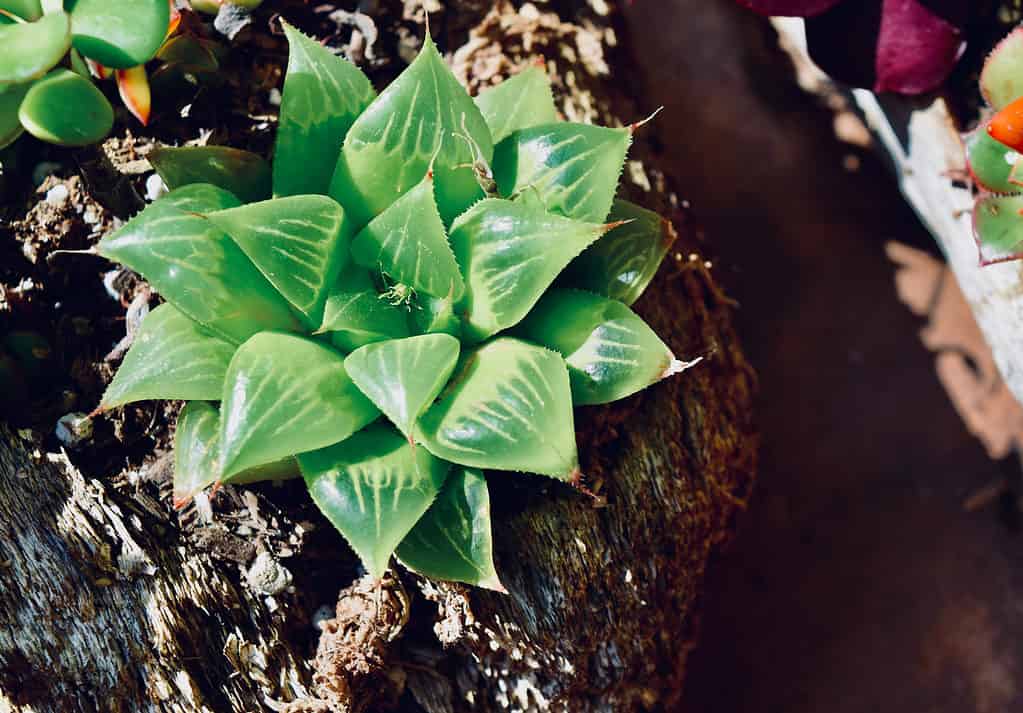
The star cactus grows to 3 inches tall by 6 inches wide over many years.
©HarmonyAzul/Shutterstock.com
This pretty Haworthia is often called the star cactus, even though it is not a cactus. It’s very slow growing and has see-through leaves in a pointy star formation.
They grow to 3 inches tall by 6 inches wide over many years and are one of the first Haworthias to bloom in late spring to early summer. Its tall 12-inch flower spike towers over the leaves with small white tubular blooms.
Are Haworthia Succulents Toxic?
No, according to the ASPCA, Haworthia succulents are not toxic, but some succulent species are. These include snake plants and euphorbias, so if you own one of these, care is needed.
How To Look After Haworthias
Haworthias are one of the simplest plants to take care of! Here’s how to keep all types of Haworthia succulents happy:
Light Requirements
Haworthias naturally grow in dry, arid conditions beneath the shade of rocks and overhangs. Replicating this natural environment is the best way to care for Haworthias, so choose a sunny spot without direct sunlight.
Haworthias are frost sensitive, so if you’re growing them outside, they’ll only tolerate zone 10 and above.
Soil Requirements
They also prefer very well-drained soil with few nutrients because they’ve adapted to cope with these harsh conditions. Rich soil and lots of fertilizer may be beneficial to leafy green rainforest plants, but Haworthias need much less.
Use cacti potting compost or a 50/50 mix of houseplant potting compost with perlite. Rich compost will make a Haworthia bolt and become leggy, which is unattractive.
Watering requirements
Haworthias are more tolerant of excess water than other more delicate succulents; however, they are still prone to rot.
Haworthias need watering when their soil is dry down to half an inch or so. Push your finger into the soil. If it’s dry, then it needs watering. If it’s damp, hold off and do the finger test in another few days.
When it is time to water it, remove your Haworthia from its display pot and place the inner pot in a sink of water. This allows the succulent to drink the amount it needs. Before replacing it in the display pot, let it drain on the side of the sink until no more water runs from its roots.
This is a good watering regime because it ensures Haworthia roots don’t rot in stagnant compost.
Are Haworthia a Cactus or Succulent?
Haworthias are a type of succulent; they are not cacti, even if they are sold alongside cactus species.
Are Gasteria and Haworthia the Same?
Though both of these succulents are native to South Africa, and they have rosette-forming leaves in a variety of colors from deep green to scarlet, they are a different genus of plant.
Although very similar, the biggest difference is their flowers. Haworthias have a narrow wiry stem that bends in several directions with small flowers that bloom in summer, whereas gasteria flowers are larger and they bloom in both winter and spring on a stem that is most often straight.
Haworthia flowers are most commonly white to pink, while gasteria’s flowers are orange. However, there are species in both geni to which this does not apply, so flower color is not a reliable indicator.
Overall, gasteria are the larger genus. Types of Haworthia succulents tend to stay 3 to 8 inches tall (although there are a handful of taller species), but gasteria can reach 24 inches tall.
How Big Will a Haworthia Get?
Haworthias are very slow-growing succulents that don’t usually get larger than 8 inches. The majority of houseplant Haworthias reach 3 to 5 inches.
Best Types of Haworthia Succulents
The Haworthia genus is huge and there are so many varieties that it’s hard to choose the best. However, if you’re planting outside, remember that zebra Haworthia and transparent types won’t tolerate the cold.
If you are a windowsill grower, then you have more choice in colder areas, but take care to keep semi-shade lovers like Haworthia pumila a touch cooler so their colors don’t bleach.
Up Next
- Are Succulents Poisonous to Dogs or Cats?
- Gasteria vs. Haworthia: Differences to Know
- Succulents vs. cactus: What’s the Difference?
The photo featured at the top of this post is © iStock.com/Mirjana Mutic
Sources
- bgci.org, Available here: https://www.bgci.org/news-events/plant-poaching-is-on-the-rise-what-can-we-do/
- aspca.org, Available here: https://www.aspca.org/pet-care/animal-poison-control/toxic-and-non-toxic-plants/zebra-haworthia
- petmd.com, Available here: https://www.petmd.com/dog/emergency/poisoning-toxicity/are-succulents-poisonous-cats-and-dogs
Thank you for reading! Have some feedback for us? Contact the AZ Animals editorial team.






